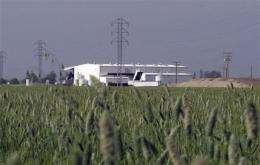Mad cow case in Calif. found in USDA testing

(AP) -- The discovery of mad cow disease in a dead dairy cow came soon after it arrived at a non-descript building in the heart of California's dairy country.
The finding, announced Tuesday, is the first new case of the disease in the U.S. since 2006 - and the fact that the discovery was made at all was a stroke of luck. Tests are performed on only a small portion of dead animals brought to the transfer facility near Hanford.
The cow had died at one of the region's hundreds of dairies. A plant official said the cow hadn't exhibited outward symptoms of the disease: unsteadiness, incoordination, a drastic change in behavior or low milk production. When the animal arrived at the facility with a truckload of other dead cows on April 18, it met criteria for government testing: older than 30 months and a fresh corpse.
"We randomly pick a number of samples throughout the year, and this just happened to be one that we randomly sampled," Baker Commodities executive vice president Dennis Luckey said. "It showed no signs" of disease.
The samples went to the food safety lab at the University of California, Davis. By April 19, markers indicated the cow could have bovine spongiform encephalopathy (BSE), a disease that is fatal to cows and can cause a deadly human brain disease in people who eat tainted meat. It was sent to an Agriculture Department lab in Iowa for further testing.
On Tuesday, federal agriculture officials announced the findings: the animal had atypical BSE. That means it didn't get the disease from eating infected cattle feed, said John Clifford, the Agriculture Department's chief veterinary officer.
It was "just a random mutation that can happen every once in a great while in an animal," said Bruce Akey, director of the New York State Veterinary Diagnostic Laboratory at Cornell University. "Random mutations go on in nature all the time."
In humans, experts say it can occur in one in 1 million people, causing sponge-like holes in the brain. But they say not enough is known about how and how often the disease strikes cattle.
The California Department of Public Health and the state Department of Food and Agriculture quickly worked to assure consumers that the food supply is safe. The cow hadn't been destined for human consumption and people cannot become ill from drinking milk, experts say. The building where the cow was selected to be tested sends animals to a rendering plants, which process animal parts for products not going into the human food chain, such as animal food, soap, chemicals or other household products.
Among the unknowns about the current case is whether the animal died of the disease and whether other cattle in its herd are similarly infected. The name of the dairy where the cow died hasn't been released, and officials haven't said where the cow was born.
"It's appropriate to be cautious, it's appropriate to pay attention and it's appropriate to ask questions, but now let's watch and see what the researchers find out in the next couple of days," said James Culler, director of the UC Davis dairy food safety laboratory and an authority on BSE.
Culler said that in this case the food safety testing program worked and that this form of BSE so rarely occurs that consumers shouldn't be alarmed.
"Are you worried about all of the meteors that passed the earth last night while you were sleeping? Of course not," Culler said. "Would you pay 90 percent of your salaries to set up all of the observatories on earth to watch for them? Of course not. It's the same thing."
The National Cattlemen's Beef Association said in a statement that "U.S. regulatory controls are effective, and that U.S fresh beef and beef products from cattle of all ages are safe and can be safely traded due to our interlocking safeguards."
The infected cow was identified through an Agriculture Department surveillance program that tests about 40,000 cows a year for the fatal brain disease.
There have been three confirmed cases of BSE in cows in the United States - in a Canadian-born cow in 2003 in Washington state, in 2005 in Texas and in 2006 in Alabama.
Both the 2005 and 2006 cases were also atypical varieties of the disease, USDA officials said.
The mad cow cases that plagued England in the early 1990s were caused when livestock routinely were fed protein supplements that included ground cow spinal columns and brain tissue, which can harbor the disease.
The Agriculture Department is sharing its lab results with international animal health officials in Canada and England who will review the test results, Clifford said. Federal and California officials will further investigate the case. He said he did not expect the latest discovery to affect beef exports.
State and federal agriculture officials plan to test other cows that lived in the same feeding herd as the infected bovine, said Michael Marsh, chief executive of Western United Dairymen, who was briefed on the plan. They also plan to test cows born at around the same time the diseased cow was.
"Our members have meticulous records on their animals, so they can tell when the animal was born, the parents, and they can trace other animals to the same facility," Marsh said.
For now, all of the other cows that arrived on the truck with the diseased one are still in cold storage at Baker's transfer station, which sits in the middle of a wheat field.
©2012 The Associated Press. All rights reserved. This material may not be published, broadcast, rewritten or redistributed.














